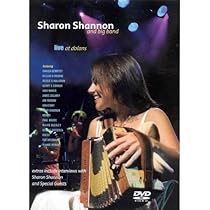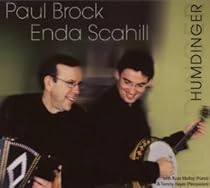 Could this be love? On first listen it certainly could. Produced by Frankie Gavin and Eugene Kelly, Michelle Lally’s first album is a work of beauty. It’s a timeless, melodic recording of songs, some very well known that have been recorded before, while others are new. The mood is one of reflection, a quiet happiness and a gentleness that fully complements the personality behind the voice. Michelle is a happy smiling person, relaxed, at ease in any company, and one whose great passion is singing. “I’ve always been singing” she says. “I sang since I was a child. My father had a pub in Ballinasloe and I’d always be up on stage singing. It was called The Dunlo Tavern, and it was the first pub in town to have music, so I’d sing with whoever was on. Even when I was in
Could this be love? On first listen it certainly could. Produced by Frankie Gavin and Eugene Kelly, Michelle Lally’s first album is a work of beauty. It’s a timeless, melodic recording of songs, some very well known that have been recorded before, while others are new. The mood is one of reflection, a quiet happiness and a gentleness that fully complements the personality behind the voice. Michelle is a happy smiling person, relaxed, at ease in any company, and one whose great passion is singing. “I’ve always been singing” she says. “I sang since I was a child. My father had a pub in Ballinasloe and I’d always be up on stage singing. It was called The Dunlo Tavern, and it was the first pub in town to have music, so I’d sing with whoever was on. Even when I was in Michelle’s musical background is essentially traditional. Her great uncle was P.J. Conlon, one of those early recording heroes of 1920’s
She has always been touched by music. While living in
After eight years there working in the fashion and make up business, Michelle returned to
Michelle sent the recording to Jimmy McCarthy who suggested she sing ‘Ride On’. He felt that the mood of the album was going to be very gentle. While Michelle is a great fan of Jimmy’s writing, ‘Ride On’ wouldn’t have been one she’d have chosen to sing. Jimmy re-wrote some of the words for her. “‘Run your claw along my gut one last time’ was very aggressive for the style of the album we were doing” she explains.” So he changed it and made the words into ‘The silver spur, the stirrup’d foot, where the road does part and wind’. Beautiful. It really worked well, that was the second song.”
Following that, Michelle gathered more beautiful songs, from Irish writers like John Spillane (All the Ways you Wander), and Mick Hanly who penned the opening title track ‘If this be Love’. “It’s an old tune that Clannad have done ‘Coinleach Ghlas and Fhómhair’. He re-wrote the words instead of translating them. It became the title track because I thought it was a great title and it represented everything that was on the album. They are all love songs in their own way. Love for your child as in ‘Wonderchild’. ‘Still by your side’ (another by Jimmy McCarthy) comes from a view of somebody who has passed away. It’s a beautiful spiritual song and it’s somebody singing back to their loved ones, ‘I’m still here, I’m still with you’. The melody is amazing.”
There are four of Jimmy’s songs on the album altogether. ‘There is no Night’ is one he composed a long time ago but had never given to anyone to sing. “It was an honour for me to get it” says Michelle. Nestling between the songs are two beautiful instrumental pieces penned by Frankie Gavin, the slightly oriental sounding ‘Ruby Rose’ and ‘Misha Mo Chroí’. Having adapted Oscar Wilde’s English words, Michelle also recorded Schubert’s ‘Ave Maria’. “I just love the melody” she says, “it’s one of those melodies that is quite hypnotic; there’s a lovely flow to it. We thought it fits on the album so we put it at the end to finish off on that kind of spiritual note.”
The songs on ‘If this be Love’ are very different to the material Michelle sings with Frankie Gavin’s band ‘Hibernian Rhapsody’. “They are more traditional” says Michelle. “Lots of Scottish Songs, Dick Gaughan songs, some Kate Rusby songs, so they would be in keeping with the old DeDanann style songs.”
Although Michelle was always aware of DeDanann’s music, it was Maura O’Connell who drew her into listening to the band. “She was the first one I listened to” she says, “and then it was Mary Black, and they were my main influences.” Maura’s first album ‘Just in Time’ was very special, “I’d close the sitting room door and I’d put it on and sing and sing and sing.” says Michelle. “That was the album that turned it around for me - an amazing album.” Michelle is still enthralled by Maura’s singing and enjoys her company whenever they meet now. Like most people, she grew up listening to a wide range of music, U2, Simple Minds and Irish band In Tua Nua were the big sounds she remembers during the 80s. “I’d listen to everything” she says. “The only thing I wouldn’t listen to would be heavy metal.”
On hearing Michelle’s album, you find yourself singing along with the melodies. The gentle tones of the songs remain with you for a long time. She’s been compared with Mary Black and while the comparison is very complementary, she is without doubt a singer with her own style. On this recording it’s one that shows maturity and an interpretative competency. “This particular style would not necessarily be the way I would describe my singing” she says. “It’s a vibe of an album, a mood we went for and we picked songs that were very light in nature that didn’t have any heaviness in them, that didn’t have any political statements. They were all very poetic, very beautiful. There’s almost a spiritual thread going from the very first to the very end without it being religious in any way, just being very positive.”
Guitarist Tim Edey joins forces with Eugene Kelly and Frankie Gavin to provide the rich accompaniment to Michelle’s voice on ‘If this be Love’. She has dedicated this first album to her own wonder child, her six year old son Evan.
She loves performing and while she’s quite busy with Hibernian Rhapsody and their concerts, she’s looking forward to including the songs from ‘If this be Love’ into her live repertoire. “I’m in a great place in my life at the moment” she says. “Thank God I can say that. It’s like the tune ‘Contentment is Wealth’, I feel very content.”
‘If this be Love’ is available on




